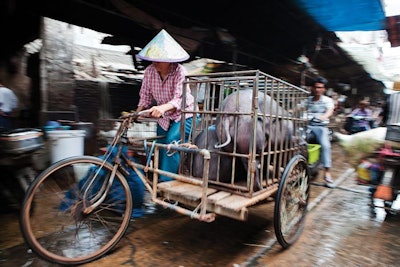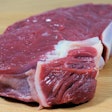
The devastating spread of African swine fever (ASF) and its ripple effect on global protein markets solidify that 2019 will, in fact, be remembered as the Year of the Pig. ASF is a highly contagious and deadly virus that infects domestic and wild swine with no vaccine or cure to treat it. It can be transmitted through the bodily fluids, tissues and excrement of infected living or dead pigs, insects and by disease vectors, such as feedstuffs, vehicles, etc.
Since August 2018, ASF has spread throughout East and Southeast Asia and parts of Europe.
China, the world’s largest pork producer and consumer, has been hit the hardest with more than 120 ASF outbreaks, spanning the entire country, and resulting in the culling of roughly 1 million pigs in an effort to contain it, reports the United Nations’ Food and Agriculture Organization (FAO).
Rabobank estimates a 25% to 35% loss in Chinese pork production in response to the disease.
“ASF has spread to every province in mainland China and is now affecting an estimated 150 to 200 million pigs, and the expected 30% loss in pork production is unprecedented,” says Christine McCracken, RaboResearch senior analyst – animal protein, noting that these losses cannot easily be replaced by other proteins nor will imports be able to fully offset the deficit.
The government has taken several preventive steps including the ban of live hog markets and swill feeding, which was found to be responsible for 34% of cases; vehicle disinfection guidelines; and pig movement controls.
As of press time, China’s Ministry of Agriculture and Rural Affairs (MARA) described the endemic virus as being “under effective control.”
Meanwhile, the virus has moved to Mongolia (six provinces) and into parts of Southeast Asia. Since early 2019, ASF has been detected in 23 Vietnamese cities and resulted in the culling of nearly 90,000 pigs, or 10% of its herd. Most recently, it was detected in backyard Cambodian pigs near the border with Vietnam, and in Tibet, near the Indian border.
Reduced breeding stocks and now gun-shy pork producers point to a slow recovery.
In Europe, ASF has been detected in wild boars throughout Eastern bloc counties, as well as outbreaks in Belgium, Poland and Romania.
“We're on high alert status,” says Nick Major, president of the European Feed Manufacturers’ Federation (FEFAC). “A lot depends on the degree to which it is confined within the wild boar population and obviously you don't want it to affect the commercial pig population. But so far in Belgium, that hasn't been the case — it is still very much a wild boar issue — unlike in Poland and Romania.”

Wild boars are the source of ASF outbreaks in Europe where the virus has yet to affect commercial pig production. (Stefan Dinse | iStock.com)
North America responds to ASF threat
North American pig industry stakeholders have been proactive in taking measures to prevent the trans-continental spread of the disease. Notably, in the United States, the National Pork Producers Council (NPPC) canceled the exhibition portion of the 2019 World Pork Expo (WPX), the world’s largest pork-specific international trade show, two months before the event.
“If ASF were to become endemic in the U.S., it would devastate the U.S. pig population and adversely reshape the pork and feed industries and negatively impact rural America,” says Joel Newman, president and CEO, American Feed Industry Association (AFIA).
To the north, the Canadian Minister of Agriculture and Agri-Food issued an order of conditions for the import and handling of select plant-based feed ingredients intended for use in livestock feed, from high ASF-risk countries, including thermal temperature and time parameters for unprocessed grains/oilseeds and meals.
“Feed importers should be able to provide feed purchasers with information on how the ingredients were produced and handled prior to entry into Canada,” states the Canadian Food Inspection Agency (CFIA).
ASF impacts trade, feed production
Brazilian and European pork exports are poised to offset some of China’s pork supply gap. According to Bloomberg, 40% of Brazilian pork exports have shipped to Hong Kong in the first two months of 2019.
Despite import opportunities, Rabobank forecasts a 10 million metric ton (mmt) supply gap in the 2019 protein supply.
Even with strained Chinese trade relations, U.S. pork producers will benefit from shortages.
“We’re really in an ASF-or-bust-type environment,” says Will Sawyer, lead economist - animal protein, CoBank’s Knowledge Exchange Division, noting that U.S. pork production is set to expand by up to 4% in 2019. “As African swine fever continues to play out, U.S. pork will keep things moving in a positive direction. If not, we’re going to have a really hard time finding a home for all the pork that we’re producing — especially at a profitable level.”
ASF has also taken its toll on grain markets and futures trading as the decline in pig production signals sizable drops in the total global feed production volume. For example, several sources estimate China’s feed production may decrease by up to 10% — or more than 19 mmt.

Given the nature of the virus and its ability to survive a variety of conditions, animal feed and feedstuffs are considered potential disease vectors. (patarapong | adobestock.com)
Feed as a disease vector
A Kansas State University study confirmed that ASF-contaminated feed could contribute to the spread of the disease. The report, “Infectious dose of African swine fever virus when consumed naturally in liquid or feed,” concluded that ASF virus “can easily be transmitted orally,” and that the virus was especially infectious in liquids.
No clear link has been made between ASF outbreaks and industrial animal feed production, as they have largely been attributed to feeding contaminated pork products and swill, lax biosecurity and swine transport.
“The dose that was required to cause infection in liquid is very low,” pointing to the highly contagious nature of the virus, lead author Megan Niederwerder, an assistant professor of diagnostic medicine/pathobiology at the Kansas State University College of Veterinary Medicine, told WATTAgNet.com.
The Swine Health Information Center (SHIC) notes that previous studies established ASF’s high stability across a diverse range of feed ingredients, noting that while “the science on viral transmission through feed and feedstuffs is still relatively young,” the theoretical ability for pathogenic swine viruses to survive transport in imported feedstuffs is likely.
Meanwhile, FEFAC is waiting for the European Food Safety Authority (EFSA) to release its Scientific Opinion on ASF and its threat to feed safety, to be released in June 2019.
The European Commission (EC) has requested EFSA estimate the risk of ASF’s spread, identify and describe the main risk factors, and evaluate the ability of matrices (hay, straw, sawdust, etc,.) to transmit the disease. The different matrices will then be ranked by their risk level “with a view to enhance preparedness and prevention” as well as “propose and assess a strategy to manage the risks posed by different matrices,” the EC says.
“There's a risk of transmission through feed materials,” says Major. “The question is, how does the feed risk rank? Is it high risk, low risk or a theoretical risk? That’s a major concern to our members, to find out where feed materials rank in that whole risk profile.”
Further ASF research related to vaccine development; the potential role of feed and feedstuffs in transmission; the efficacy of feed additives solutions to combat it; and best practices regarding storage times, thermal processing and chemical additive treatment is ongoing.

African swine fever outbreaks have occurred in all mainland Chinese provinces, depleting herds by more than 50% in some confined areas. (Jef Wodniack | iStock.com)
Biosecurity guidelines for feed manufacturers
Feed industry stakeholders urge that any measures put into place to tackle the ASF threat involve scientifically based prevention and biosecurity measures.
In response to the ASF crisis, AFIA has updated its biosecurity guidelines to prevent the virus’ introduction in to the feed manufacturing process.
“The updated guidelines provide recommendations to help facilities create on-site biosecurity programs, more thoroughly evaluate and verify their suppliers, work with shippers, and train on and communicate best practices to all facility personnel and visitors,” Newman explains.
The implementation of an effective biosecurity plan can significantly reduce the risk of disease contamination and ensure feed safety, says David Fairfield, senior vice president for feed services, National Grain & Feed Association (NGFA). (See “Feed mill biosecurity checklist”)
Here are several ways feed mill best practices can mitigate ASF contamination risks:
Hygiene enforcement
Hygiene control measures are critical to all biosecurity protocols. Enforcing diligent vehicle hygiene (spraying trucks) and monitoring the movement of feed mill employees who visit farms is critical. For example, drivers should wear and discard all disposable clothing at the farm.
“Feed mills should work closely with their customers to ensure appropriate procedures are identified and followed during feed delivery,” Fairfield says.
He also suggests limiting personnel access to specified areas within the feed mill to reduce the potential transmission of biological hazards.
Receiving and ingredient specifications
A key component of an effective feed mill biosecurity plan is prevention of the entry of hazards during the receiving of ingredients.
“Typically, the first step for hazard prevention during receiving involves a supplier approval process that includes development and communication of appropriate ingredient specifications,” Fairfield explains. “In addition, the supplier approval program should have methods to verify that the supplier has effective programs in place to ensure ingredients meet necessary specifications.”
AFIA’s updated guidance defines what “biosecure” actually means and suggests feed manufacturers only source from biosecure facilities.
SHIC produced a “decision tree” to help pork producers determine if their feed suppliers to minimize risk from feed ingredients. (See Resources sidebar)
Foreign supplier verification, ingredient holding times
Newman suggests the feed industry should “take the verification of foreign suppliers one step further than dictated by FSMA and consider foreign suppliers’ biosecurity programs.”
“We must continue working with suppliers to provide assurance of where ingredients are sourced and confidence in the biosecurity practices being used at our ingredient and feed processing facilities,” Newman says.
The risk assessment of globally sourced ingredients should take into account the point of origin, distribution methods and associated supply chain entities, Fairfield notes.
“Research has shown the potential for other animal viruses to survive transboundary shipments in certain feed ingredients after inoculation,” Newman says.
SHIC, for example, suggests holding times based on the calculated half-life of viruses for feed ingredients sourced high ASF-risk countries. The Canadian Pork Council (CPC) recommends holding feed ingredients at a temperature of 20 degrees Celsius for 20 days or 10 degrees Celsius for 100 days.
In April, AFIA’s IFEEDER and South Dakota States University’s will release the results of its study of how holding times may reduce viral loads in feed ingredients.
References available upon request.
Feed mill biosecurity plan checklist
- Identify known or reasonably foreseeable biological hazards, and determine where such hazards may be potentially introduced, amplified or controlled within the receiving/processing/distribution systems.
- Access the probability and severity of known or reasonably foreseeable hazards.
- Determine and implement appropriate controls to mitigate the risk posed by such hazards.
- Take steps to verify that the controls are implemented effectively and are adequately controlling the hazard.
- Document the control and verification activities.
- Review the plan periodically to assess for potential new hazards and to identify ways to improve implementation.
Source: Fairfield, NGFA
African swine fever facts and feed safety resources
• American Feed Industry Association “Biosecurity guidelines” bit.ly/2Z2oSLg
• Kansas State University feed safety resources bit.ly/2uZxbtF
• Swine Health Information Center’s “Decision tree matrix to minimize viral transmission risk from feed ingredients bit.ly/2Nun2jo
• European Commission Disease Control Measures: African swine fever bit.ly/2nrBWId
• Canadian Food Inspection Agency African swine fever facts and guidance bit.ly/2P3bTEt
• United States Department of Agriculture (USDA) Animal and Plant Health Inspection Service (APHIS) ASF technical documents and related materials bit.ly/2ul8aZl
• National Pork Board “Biosecurity for pork producers” manual bit.ly/2Dc7R8e
• United Nations FAO’s African swine fever news and situation updates bit.ly/2B2h3ve
• World Animal Health Information (OIE) real-time outbreak map bit.ly/2D4yfk3

















